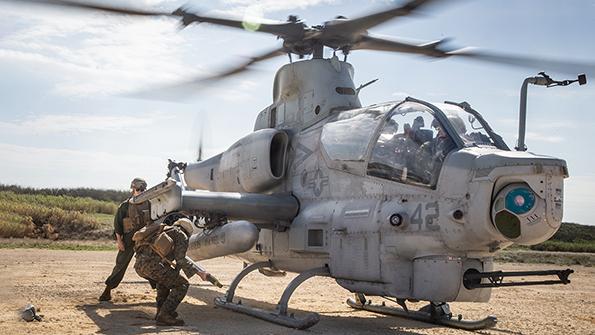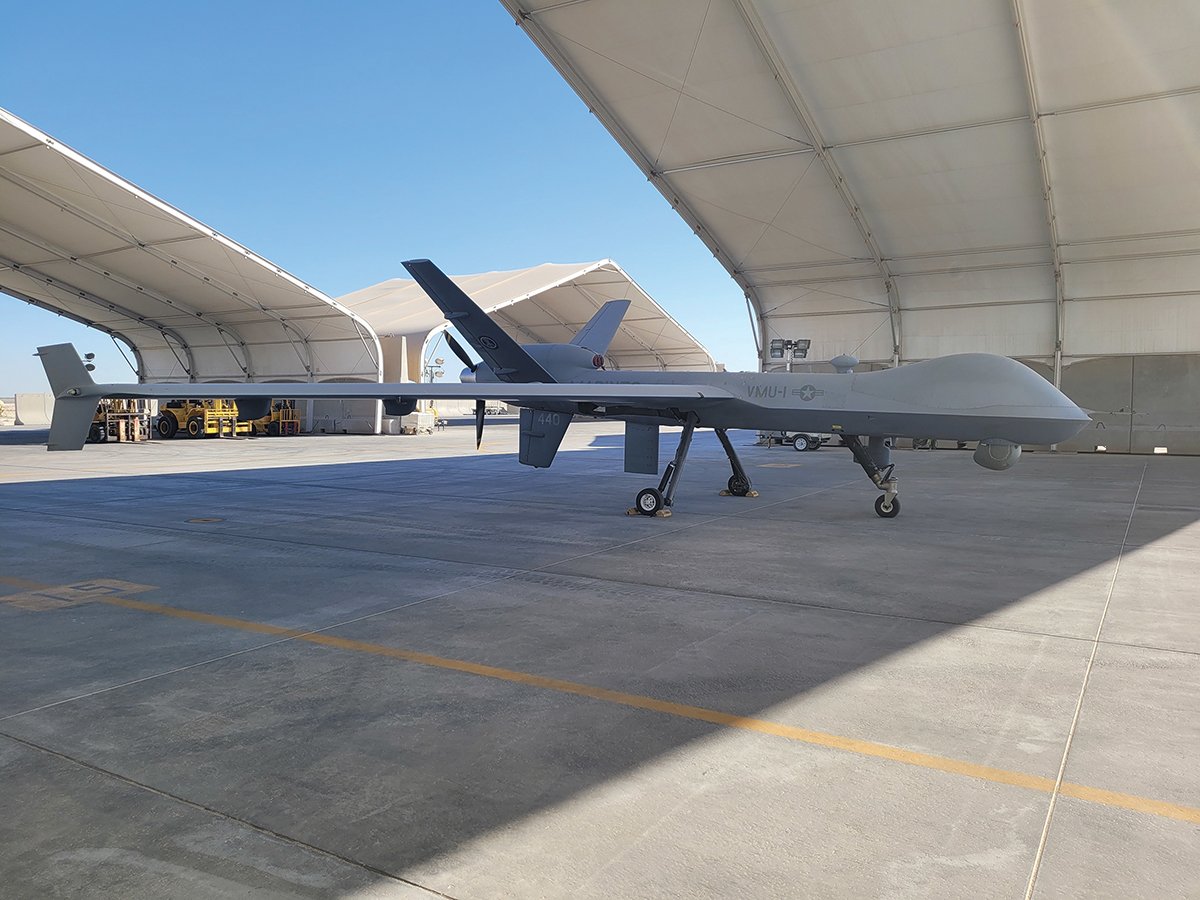This article is published in Aviation Week & Space Technology and is free to read until Jun 06, 2024. If you want to read more articles from this publication, please click the link to subscribe.
U.S. Marine Corps Readies New Aviation Modernization Plan

Weapons and power upgrades are coming for the AH-1Z fleet, even as the Marines consider options for a long-term replacement.
A new wave of investment in U.S. Marine Corps aviation has taken shape behind closed doors during the past 18 months, as the development of several new rotary-wing platforms and a new munition is set to move forward as part of the fiscal 2026 budget rollout next year.
The short-term plans include fielding a new missile for the Bell AH-1Z Viper and UH-1Y Venom fleets, developing a prototype for a fleet of uncrewed aerial logistics connectors and the revival of an expanded portfolio of Marine Air-Ground Task Force Unmanned Aerial System Expeditionary platforms, starting with a new tactical air option and proceeding to a more advanced follow-on to the Marines’ recently—and reluctantly—acquired General Atomics Aeronautical Systems MQ-9A Reapers.
- Common replacement for H-1 and V-22 is being considered
- Aerial logistics connector is the next acquisition priority
More radical changes are possible beyond the short term, taking aim at resolving the limitations of the Bell Boeing MV-22 Osprey and identifying a replacement for the AH-1Z and UH-1Y fleets. A range of possibilities remains under consideration, including replacing all three with a single new platform in the long term; the future variant of the Bell V-280 Valor is a possible candidate.
“Does it look like, for example, one platform that maybe replaces a V-22 of the future and the H-1s of the future and serves that multirole [capability]?” Col. Eric Ropella suggested to Aviation Week at the Modern Day Marine expo on May 2. “Or is it something that’s maybe smaller and doesn’t have the ability to have that flexibility because it needs to be smaller and faster and agile, and one platform can serve all of those? Is it autonomous, or is it going to be crewed? . . . We’re still in that consideration phase of what is next,” Ropella added.
Until recently, the Marine Corps hoped to move quickly to replace the H-1 fleet, even as Bell delivered the last examples that the U.S. military had ordered a year ago. However, the Marines paused the Attack Utility Replacement Aircraft (AURA) program in 2020, then shelved the concept a few years later.
In 2023, Marine Corps leadership launched the sweeping Project Eagle study, which is plotting a detailed 15-year modernization plan for the aviation branch. The Marines have completed acquisitions of MV-22Bs, AH-1Zs and UH-1Ys. As orders of Lockheed Martin F-35Bs, F-35Cs and Sikorsky CH-53Ks continue into the next decade, Project Eagle is addressing the gaps and limitations in other Marine Corps areas, with a special focus on the light and medium-size rotorcraft fleet. The results are intended to be released later this year in the annual update to the Marine Corps Aviation Plan, which will inform the service’s requests for the fiscal 2026 budget.

“Hey, we’re in a good spot right now,” Lt. Gen. Bradford Gering, the deputy commandant for Aviation, said during a panel at Modern Day Marine. “We’ve got new aircraft that are incredibly capable, incredibly lethal, and that gives us decision space. We’re continuing to upgrade this aircraft to make it even more lethal and more sustainable.”
Major upgrades for the MV-22 and H-1 fleets are underway. In March, Bell inducted the first AH-1Z Viper into the structural improvement and electrical power upgrade program, increasing the aircraft’s onboard power to support future weapons and electronic warfare capabilities. Starting in 2026, the Marines plan to launch the V-22 Cockpit Technology Replacement program, which will address obsolescence of such items as cockpit displays, keyboards, weather radar and mission computers.
A new long-range weapon is also being added to the H-1 arsenal. A solicitation released in September specified a Long-Range Attack Munition (LRAM) that could attack a target up to 150 nm away with a 25-lb. payload. “Take everything that you know about an H-1 and the ordnance that it can throw off of it, and then exceed that range by a lot. You’ll get LRAM,” Ropella said at Modern Day Marine.
Captive carry testing on the H-1 fleet has started with an LRAM candidate. A live-fire test is scheduled for later this year. Ropella declined to identify the LRAM being tested, except to note that it is a munition developed for the Air Force’s fixed-wing fleet that the Marines have adapted for rotary-wing aircraft.
More difficult decisions await the Marines’ aviation branch, however. The V-22 program office has launched a study looking at a package of considerable upgrades for the Osprey fleet after 2036. A starting point for the Renewed V-22 Aircraft Modernization Program leaves the fuselage unchanged but replaces the engines, drivetrain, nacelle and wing of the tiltrotor, said Col. Brian Taylor, the V-22 program manager.
The study’s findings will inform future decisions on modernization for the program’s three variants: the Marines’ MV-22, Air Force’s CV-22 and the Navy’s CMV-22B. At that point, the operators may have other options to consider, including a new version of the V-280 and DARPA’s Speed and Runway Independent Technologies program, which is developing a proof of concept for a large, high-speed vertical-takeoff-and-landing aircraft.
“I would love to see the V-22 stay in service for the next 100 years,” Taylor said at Modern Day Marine. “But if there’s a better thing that we need to pivot to, that’s really up to the services as to whatever the platform is, how it fits into their mission.”
In the meantime, the Marines are in no rush to replace the H-1 fleet, but Bell’s V-280 team is applying pressure for a near-term decision. The most efficient path for the Marines to launch a development program would be immediately after the Army version is completed by the end of the decade, Tyler Harrell, Bell’s manager for military sales and strategy, told Aviation Week at the same event. The Marine variant would require several changes, including the addition of weapons, a refueling probe, more fuel tanks and marinization, including a blade fold and wing stow system. The latter would add about 1,100 lb. to the weight of the Army version of the Valor, Harrell said.
Large uncrewed aircraft systems (UAS) are another long-term requirement for the Marines. Four years ago, the service canceled a plan to acquire the ship-based Marine Air-Ground Task Force UAS Expeditionary (MUX), which was meant to perform a range of tasks, including electronic warfare, airborne early warning and intelligence, surveillance and reconnaissance. Instead, the Marines acquired a small number of land-based MQ-9As—but only as an interim capability. The Reapers fall short of the Marines’ requirement.
“It is not the perfect platform,” said Lt. Col. Leigh Irwin, the director for Marine Corps Programs at Naval Air Systems Command. “It may not do everything the Marine Corps wanted [for MUX], but it’s the fastest thing we can get out there now and we can continue to build upon.”
Since October, the Marine Corps has been experimenting with the Kratos XQ-58 Valkyrie. The first two of five or six test flights have been completed under the Penetrating Affordable Autonomous Collaborative Killer-Portfolio program. But the Marines have not released a timeline for a follow-on acquisition program of a long-term MUX fleet.
Instead, the next major UAS acquisition for the Marines could be the aerial logistics connector (ALC). The Marines have selected four undisclosed companies to participate in a recently approved competitive process that will use the streamlined Middle Tier of Acquisition authority. One of the four companies will be selected for Phase 2 of the ALC program.






